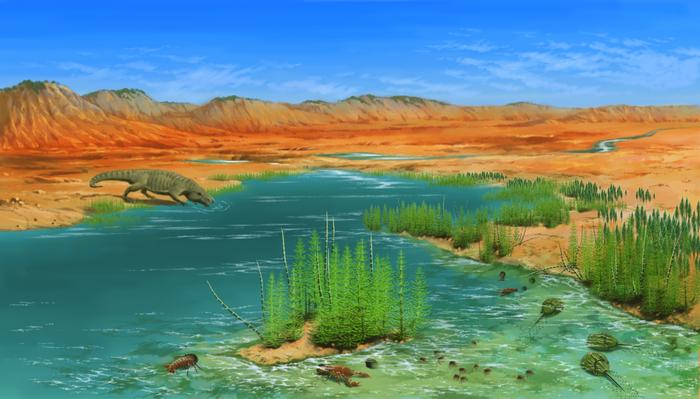
Tropical riparian ecosystems, which thrive along rivers and wetlands, have surprised researchers with their remarkable resilience and rapid recovery following the cataclysmic end-Permian mass extinction that transpired approximately 252 million years ago. According to a groundbreaking study published in eLife, these ecosystems rebounded much more quickly than previously anticipated, defying long-held assumptions about the prolonged devastation of terrestrial life after one of Earth’s most severe extinction events.
The end-Permian mass extinction stands as a historical marker, having eradicated over 80% of marine species and approximately 70% of terrestrial species. This mass extinction was driven by catastrophic environmental shifts such as global warming, prolonged droughts, and rising ocean acidity, which severely disrupted ecosystems worldwide. In the wake of such devastation, scientists had theorized that low-latitude land regions remained inhospitable for millions of years. However, the latest findings indicate that certain ecosystems, particularly tropical riparian areas, exhibited a level of adaptability and quick recovery that challenges traditional narratives.
Led by Dr. Li Tian, a prominent researcher at the State Key Laboratory of Biogeology and Environmental Geology at the China University of Geosciences in Wuhan, the study utilized an extensive array of fossil evidence to reconstruct the timeline of ecological recovery. The researchers focused on sediments, trace fossils, and plant and vertebrate remains from the Heshanggou Formation in North China. By employing sophisticated techniques such as biostratigraphy, sedimentology, and ichnology, the team meticulously analyzed the fossil record from the Early Triassic, a period directly following the mass extinction.
Initial findings describe a harsh and barren environment at the onset of the Early Triassic, characterized by sparse and simplistic life forms. The fossils recovered from this timeframe revealed a predominance of monospecific communities, where a single organism type persisted amidst a notable decline in biodiversity. Remarkably, these fossils also indicated a decrease in organism size compared to biotic assemblages prior to the extinction event—a pattern often associated with significant environmental stress.
However, as the research advanced into the Spathian stage approximately 249 million years ago, an invigorating transformation was observed. The fossil record began to reflect a burgeoning ecosystem, replete with increased plant remains and evidence of burrowing activity among vertebrates. This resurgence indicated a shift toward a more stable environment, suggesting that the ecological landscape was beginning to recover from the hostile conditions of the preceding era. The presence of medium-sized carnivorous vertebrates pointed to the establishment of complex food webs, reinforcing the idea that ecological networks were gradually reasserting themselves.
One of the pivotal discoveries in this study was the reappearance of burrowing behavior, which had been significantly diminished post-extinction. Burrowing activities are crucial for eco-stability as they enhance soil aeration and facilitate nutrient cycling—vital processes in any burgeoning ecological community. The researchers theorize that this behavior underscores the ability of these early inhabitants to adapt to lingering environmental pressures. By seeking refuge underground, these organisms likely enhanced their survival rates amid the harsh conditions of their habitats.
The outcomes of this research invite a reevaluation of previously accepted timelines regarding ecosystem recovery, positing that certain ecosystems, particularly riparian zones, might have stabilized within geological timescales significantly shorter than traditionally thought. The study’s implications extend beyond academic curiosity; they may offer vital insights into contemporary ecological resilience, shedding light on how ecosystems can adapt and recover following catastrophic changes.
Further investigations are necessary to determine if comparable recovery patterns were observable in other regions during the Early Triassic. These findings could dramatically enhance our understanding of biotic responses to mass extinctions and might provide critical lessons for today’s ecosystems, especially as we face pressing challenges posed by modern climate change.
In contemplation of how life manages to rebound from such severe adversity, researchers highlight that riparian zones may have played an instrumental role in the stabilization of post-extinction ecosystems. These areas potentially acted as refuges where more stable environmental conditions allowed life to rebound more effectively than in drier, inland regions. This emerging narrative paints a more nuanced picture of the resilience of life on Earth, inspiring hope for the adaptability of current ecosystems amid ongoing anthropogenic pressures.
By elucidating the dynamics of ecosystem recovery following one of history’s most catastrophic events, this research not only enriches our understanding of the past but also offers critical perspectives for conservation efforts today. The nuanced findings serve as a reminder that even in the face of drastic change, life finds a way to adapt, evolve, and eventually flourish once again.
In conclusion, the insights gleaned from this study not only reshape our understanding of prehistoric life but also embolden the fight for ecological preservation in the present day. As the planet grapples with climate warming and habitat destruction, the lessons of the past could illuminate paths forward, guiding strategies aimed at safeguarding biodiversity and ecosystem functions.
Subject of Research: Tropical riparian ecosystem recovery post-end-Permian mass extinction
Article Title: Rapid riparian ecosystem recovery in low-latitudinal North China following the end-Permian mass extinction
News Publication Date: 14-Feb-2025
Web References: eLife
References: eLife Study on Ecosystem Recovery
Image Credits: Credit: Mr J Sun (CC BY 4.0)
Keywords: End-Permian mass extinction, Tropical riparian ecosystems, Ecosystem recovery, Paleontology, Trace fossils, Environmental resilience, Biostratigraphy, Early Triassic, Burrowing behavior, Biodiversity, Ecological adaptation, Climate change
Tags: adaptability of low-latitude ecosystemsbiogeology and extinction studiesDr. Li Tian research findingsecosystems and climate changeend-Permian extinction recoveryenvironmental shifts and biodiversityfossil evidence of ecosystem recoveryhistorical analysis of extinction eventsimpact of global warming on ecosystemsrapid recovery after mass extinctionterrestrial life post-extinctiontropical riparian ecosystems resilience





